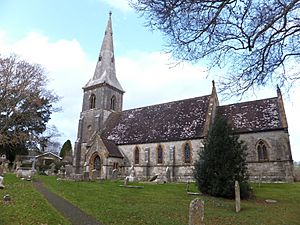St Mary's Church, Bradford Peverell facts for kids
Quick facts for kids St Mary's Church |
|
|---|---|
 |
|
| Religion | |
| Affiliation | Church of England |
| Ecclesiastical or organizational status | Active |
| Year consecrated | 1850 |
| Location | |
| Location | Bradford Peverell, Dorset, England |
| Architecture | |
| Architect(s) | Decimus Burton |
| Architectural type | Church |
| Architectural style | Early English |
St Mary's Church is a special building in Bradford Peverell, Dorset, England. It is a Church of England church, which means it is part of the main Christian church in England. A famous architect named Decimus Burton designed it. The church was built between 1849 and 1850. It is considered a very important historical building, known as a Grade II* listed building. This means it has special protection to keep it safe for the future.
In the churchyard, there is also a war memorial for Bradford Peverell. This memorial remembers the people from the village who lost their lives in the First and Second World Wars. It was finished and put up in January 1921. The memorial is made from strong Dartmoor granite. It also became a Grade II listed monument in 2015, showing its historical importance.
Contents
The Story of St Mary's Church
Why a New Church Was Built
St Mary's Church was built because the old church in Bradford Peverell was falling apart. The original church was very old and quite small. It had a main hall called a nave, a special area near the altar called a chancel, a side section, and a porch. It also had a wooden tower with three bells.
By 1847, people decided it was time to build a new church. Decimus Burton, the architect, started drawing plans for the new building. A local builder from Dorchester, John Wellspring, estimated how much it would cost to build.
Building the New Church
Decimus Burton finished his plans in 1848. In 1849, permission was given to take down the old church and build the new one in the same spot. Most of the money for the new church came from Hastings Nathaniel Middleton. He was the Lord of the Manor, a very important person in the area.
John Wellspring's team built the church. St Mary's Church was officially opened and blessed on October 28, 1850. The Bishop of Salisbury, Edward Denison, led the special ceremony.
Later Additions to the Church
The church got its organ in 1888. It was built by a company called Bishop and Son from London. The churchyard, which is the area around the church, was made bigger around 1888. It was expanded again around 1955.
Looking at the Church's Design
What St Mary's Church Is Made Of
St Mary's Church is built from rough stone blocks called ashlar. It has smooth stone details and roofs made of clay tiles. The church has a long main hall (nave) and a chancel. It also has a tall tower at the west end with an eight-sided spire made of Portland stone. There is a small room called a vestry on the north side and a porch on the south side.
The pulpit, where sermons are given, and the font, used for baptisms, are from the 1800s. The tower has five bells. One of these bells was made way back in 1674! Two more bells were added in 1897.
Old Pieces in the New Church
When the new church was built, some items and memorials from the old church were moved into it. In the west tower, there is a marble plaque remembering a rector named Rev. Middleton Onslow from 1837. On the floor of the nave, there are old stone slabs. These remember people like John Jobbins (1696) and members of the Meggs family from the late 1600s and 1700s.
Above the arch leading into the tower, you can see the Royal coat of arms of Queen Victoria. Inside the tower, there are also two stools and a table that are very old, dating back to the 1600s.
Special Windows and Memorials
The east window in the chancel is very special. It was made using pieces of stained glass from the 1200s and 1300s. These pieces came from a chapel at New College, Oxford. In 1850, Hastings Nathaniel Middleton visited Oxford to see the glass. The college offered it to him for the new church.
The north window in the chancel also has old glass pieces from the original church. These pieces show the coat of arms and motto of William of Wykeham, a famous bishop.
Inside the chancel, there is a marble plaque for Rev. H. Blackstone Williams from 1879. In the nave, there are brass plaques remembering members of the Middleton family who served in wars. These include Frank Middleton (1915), Ernest Middleton (1917), Captain Thomas Winwood (1919), and Walter Middleton (1931). There are also stained glass windows that remember other Middleton family members. One window remembers Lieutenant Edward Williams, who died in the Sudan campaign. Another remembers Vice-Admiral Sir Robert O'Brien FitzRoy.
Churchyard Tombs
In the churchyard, there are four old stone tombs shaped like tables. These became Grade II listed in 1985. Three of them belong to the Dearing family and date back to the late 1600s. One of these is for Luke Dearing the Elder from 1666. The fourth tomb belongs to Hastings Nathaniel Middleton, who passed away in 1821.

